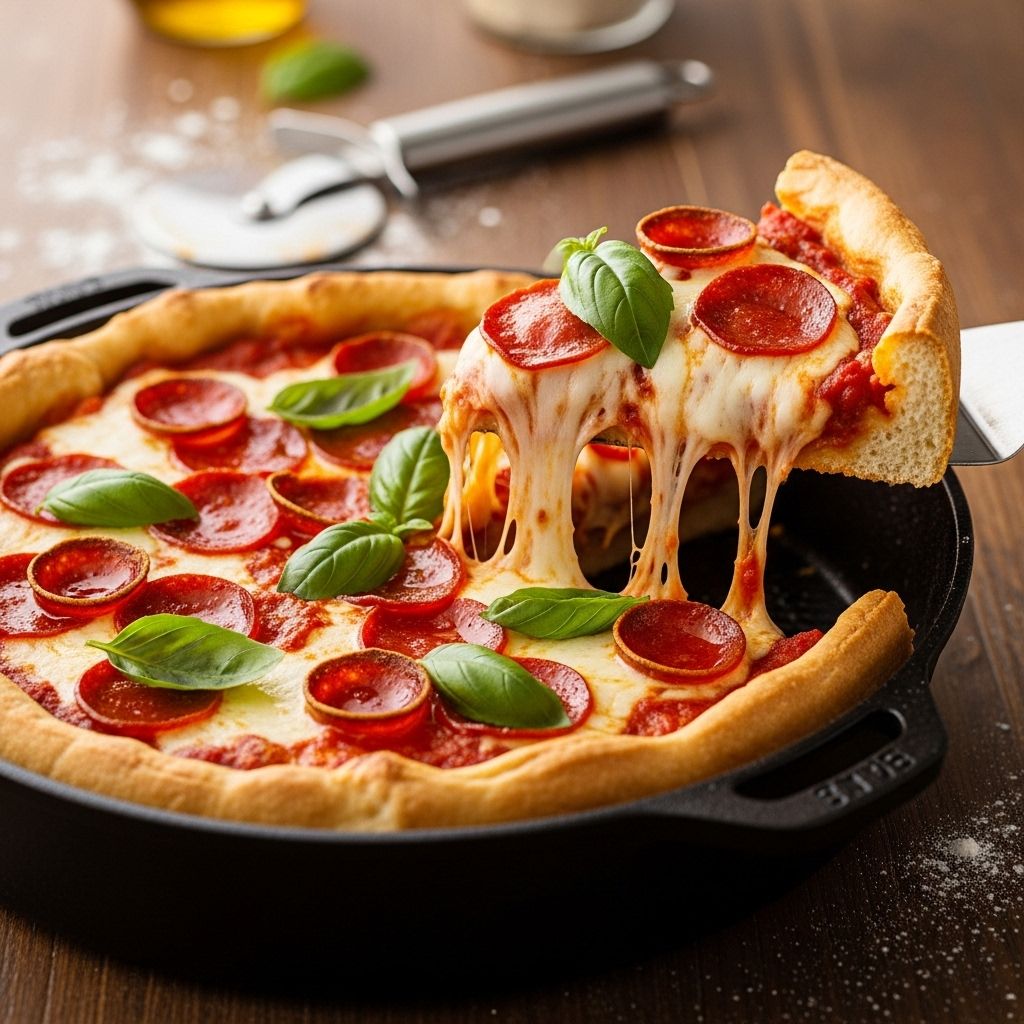Foolproof Pan Pizza: Easy Guide To Pizzeria-Style Perfection
A simple, no-knead method delivers a crunchy crust and lacy cheese edges every time.

Foolproof Pan Pizza: Achieving Pizzeria Perfection at Home
Dreaming of bubbly, crisp crust adorned with molten cheese and tangy tomato sauce, all from your own oven? This foolproof pan pizza recipe combines minimal labor, maximum flavor, and cast-iron magic to help anyone achieve golden, pizzeria-quality pizza right at home—no kneading, no special oven required.
Why This Pan Pizza Recipe Works
- No-Knead Simplicity: Skip tiresome kneading. This dough formula uses long, slow fermentation to build gluten naturally.
- Cast-Iron Crispness: The heavy skillet creates a delightfully crunchy, almost fried bottom crust.
- Cheese-Laced Edges: Cheese-to-the-edge technique means caramelized, lacy cheese where the dough meets the pan.
- Flexible and Forgiving: The recipe tolerates minor errors in measurement and adapts to your schedule.
Table: At-a-Glance Pan Pizza Advantages
| Feature | Benefit |
|---|---|
| No Knead | Less effort, just a quick stir |
| Cast Iron Pan | Crispy, golden crust and even baking |
| Overnight Rise | Complex flavor, open crumb |
| Cheese-to-Edge | Lacy, caramelized outer crust |
| Versatility | Adaptable to toppings and pan size |
Ingredients and Equipment
For the Dough:
- 400g (about 3 cups) bread flour or all-purpose flour
- 10g (about 2 teaspoons) kosher salt
- 4g (about 1 teaspoon) instant yeast
- 275g (about 1 1/4 cups plus 1 tablespoon) water, room temperature
- 20g (about 1.5 tablespoons) olive oil, plus more for greasing pans
For the Pizza:
- 1.5 to 2 cups shredded whole-milk low-moisture mozzarella
- 1 cup tomato sauce (preferably simple, uncooked, slightly chunky)
- Preferred toppings (pepperoni, vegetables, olives, etc.)
- Additional olive oil for drizzling
- Kosher salt and black pepper to taste
- Grated Parmesan or Pecorino Romano cheese (optional, for finishing)
Equipment Needed:
- Two 10-inch cast-iron or nonstick cake pans (or a single 14-inch pan; reduce dough by 25% if using a single pan)
- Mixing bowl and spoon or dough spatula
- Plastic wrap or airtight container for rising dough
- Bench scraper or spatula (for dividing and handling dough)
Step-by-Step Instructions
1. Mixing the Dough (the night before)
Combine flour, salt, and yeast in a large bowl. Add water and olive oil. Stir with a stiff spoon or dough whisk until just combined; the dough should be sticky and a bit shaggy.
- Tip: No kneading is needed, but ensure no dry flour remains. Use hands or a spatula to scrape down sides if necessary.
2. First Rise (Overnight, 8–24 hours)
Cover the bowl tightly with plastic wrap or a lid. Leave at room temperature to ferment overnight. The dough should expand 2–3 times in volume and look bubbly with a webby, stretchy texture.
- Fermentation builds flavor and improves texture.
3. Pan Prep and Dough Division
Pour 1–2 tablespoons olive oil into each pan, swirling to coat the bottom and sides liberally.
Turn dough out onto a lightly oiled work surface. Use a bench scraper to divide into two equal pieces.
- Shape each half into a round ball by gently stretching and tucking the dough underneath itself.
- Flip each ball smooth-side-up, then transfer to the prepared pans.
4. Stretch and Second Rise
With greased fingers, gently press and stretch the dough toward the pan edges — it likely won’t reach fully at first, which is normal. Cover pans with plastic wrap and let rest at room temperature for 2 hours (or up to 6 hours in the fridge).
- After resting, the dough will be more relaxed. Press and stretch again until the dough fills the pan and evenly covers the surface.
- Pop any large bubbles with your fingers to prevent burnt blisters.
5. Adding Toppings
- Cheese first: Scatter cheese over the dough, all the way to the edge to form the signature caramelized border.
- Sauce next: Dollop or drizzle tomato sauce atop the cheese, leaving some exposed areas for textural contrast.
- Toppings: Layer on pepperoni, veggies, or other options as desired.
6. Baking
Place pans on the bottom rack of a preheated 500°F (260°C) oven. Bake until the cheese is deeply browned and bubbly, edges are crisp and caramelized, and the crust is golden when lifted gently with a spatula—20 to 25 minutes.
- Optional: For ultra-crisp edges, switch from oven to stovetop for the last minute, setting the pan over medium heat.
7. Serving and Finishing Touches
- Let the pizza cool in the pan for 2–3 minutes to help the crust set.
- Run a thin spatula around the edge to release crispy cheese bits.
- Transfer to a cutting board, cut into wedges or squares.
- Finish with olive oil drizzle, Parmesan, or fresh basil if desired.
Visual: Classic Pan Pizza Crust Traits
- Bottom: Evenly golden, crisp, almost fried from the olive oil.
- Edge: Tall, darkly golden ring of cheese, crisp and lacy.
- Interior: Chewy, open crumb with fermented fragrance.
Troubleshooting and Frequently Asked Questions
My dough isn’t stretching to the edge!
It’s normal for the dough to resist initially. Resting it (covered) for 10–15 minutes allows the gluten to relax; repeat pressing/stretching. As the dough warms, it will fully fill the pan.
The crust is soft, not crisp.
- Ensure the pan is coated with enough oil—this fries the base as it bakes.
- Bake on the bottom rack at high heat for best color and crunch.
- Let the pizza cool slightly before removing to prevent steam-sogging.
Can I use all-purpose flour?
Yes, both bread and all-purpose flour work, resulting in slightly different textures but both excellent.
How can I make this in advance?
- The dough can rest in the refrigerator for up to 48 hours for even more flavor complexity.
- Formed dough balls can be refrigerated in pans up to 6 hours before baking.
Can I freeze the dough?
Yes. After the first rise, divide and shape. Wrap balls well in plastic and freeze for up to 3 months. Thaw overnight in the fridge, bring to room temperature before stretching in the pan.
What’s the best sauce and cheese?
- Use a simple, uncooked tomato sauce with a bit of salt and olive oil for Italian-style flavor.
- Whole milk, low-moisture mozzarella shreds best and browns beautifully; don’t use fresh mozzarella, which can release too much water.
Creative Twists and Customizations
- Alternative cheeses: Blends like fontina, provolone, or cheddar add nuanced flavor.
- Spice the sauce: Add red pepper flakes, oregano, or garlic for punch.
- Loaded toppings: Pre-cook watery veggies (like mushrooms or spinach) to prevent a soggy crust.
- Size swap: Use a single 12–14 inch cast iron skillet (reduce dough by ~25%) for a larger, party-sized pizza.
Step-by-Step Pan Pizza Recipe
- Mix flour, salt, and yeast. Add water and oil. Stir to form a wet, lumpy dough. Cover and leave to rise overnight at room temp.
- Oil pans thoroughly. Divide dough, shape into balls, and place in pans. Cover and let rest 2 hours; stretch to fill pans.
- Top with cheese (to edge), sauce, and additional toppings.
- Bake at 500°F on lower rack for 20–25 minutes, until bubbly, browned, and crisp.
- Cool slightly; loosen edges, remove, slice, and serve hot.
Table: Troubleshooting Common Issues
| Issue | Solution |
|---|---|
| Dough too sticky to handle | Oil hands and work surface; dough will firm as it ferments |
| Won’t stretch to pan edge | Rest longer; repeat stretching after 10 min |
| Soft/soggy crust | Increase oil, bake lower in oven, check oven temp |
| Cheese burns but crust not done | Use lower rack; if problem persists, cover with foil in last 5 mins |
| Crust stuck to pan | More oil; let pizza cool before removing |
Expert Tips for Best Results
- Use plenty of olive oil in the pan—essential for crispiness and flavor.
- Let dough fully ferment: Overnight is best for open crumb and complex taste.
- Cheese-to-edge: A must for the signature caramelized perimeter.
- Allow brief cooling in the pan to help set the bottom before slicing.
Frequently Asked Questions (FAQs)
Q: Do I need a cast iron pan?
A: Cast iron gives the best results, but heavy nonstick cake pans work in a pinch.
Q: Can I use fresh mozzarella?
A: It’s not recommended here due to excess moisture; low-moisture mozzarella ensures the best melt and browning.
Q: How long does pan pizza stay fresh?
A: Best eaten fresh, but leftovers can be stored in the fridge for up to 3 days and reheated in a skillet or hot oven for crispness.
Q: Can I use active dry yeast?
A: Yes; dissolve in the water before mixing with flour. Instant yeast can be mixed directly with dry ingredients.
Final Thoughts: The Joy of Foolproof Pan Pizza
This approachable method makes pizzeria-style pan pizza possible for any home cook. With a forgiving dough, a simple cast iron skillet, and a hot oven, you can produce a pie that’s crisp, cheesy, and deeply satisfying—every time. Experiment with toppings, and discover your own signature slice.
Read full bio of Shinta












